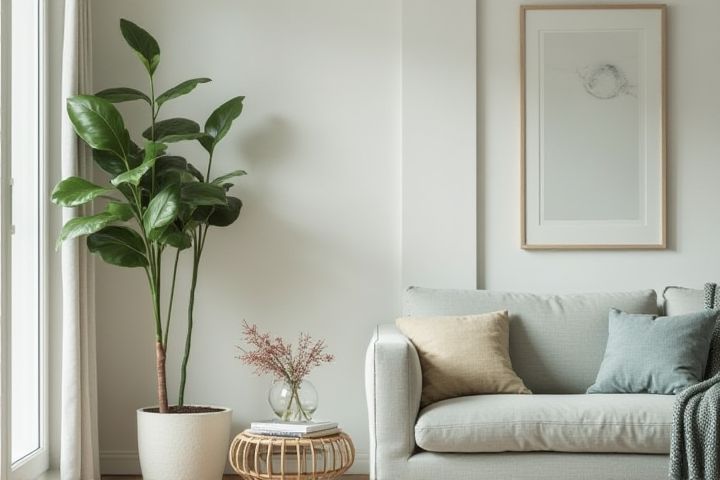
Consider the architectural style of your home when selecting house paint colors, as it can influence the overall aesthetic. Assess the surrounding environment, including landscape and neighboring homes, to ensure your choice harmonizes with the setting. Utilize color samples to visualize how different shades appear in varying lighting conditions throughout the day. Think about the mood you want to create; lighter shades can make spaces feel more open and airy, while darker colors may add warmth and coziness. Finally, remember to take into account the permanence of your choice, as paint color can significantly impact home value and curb appeal.
How To Choose House Paint Colors
Consider natural light.
When selecting house paint colors, consider the impact of natural light, as it significantly affects how colors appear throughout the day. Rooms bathed in bright, direct sunlight often make hues look lighter and more vibrant, while spaces with limited natural light may require warmer or brighter shades to avoid a dull appearance. You can test paint samples on your walls, observing them at various times of the day to ensure they complement the light conditions. Remember, the orientation of your home -- whether it faces north, south, east, or west -- also influences how colors will be perceived within your living spaces.
Complement exterior elements.
Choosing house paint colors requires careful consideration of how they complement exterior elements such as roofing, brickwork, and landscaping. For instance, if your home has a dark slate roof, soft neutrals or light pastels can create a beautiful contrast while maintaining harmony. Using a color wheel can help you identify complementary shades that enhance wood accents or stone features, ensuring a cohesive look. You might consider using two or three colors to define architectural details or entrances, where a dominant color paired with an accent can highlight your home's character effectively.
Factor in architectural style.
When selecting house paint colors, it's essential to consider your home's architectural style to enhance its visual appeal. For instance, Victorian homes often benefit from bold, rich colors, utilizing three or four complementary shades to accentuate intricate details. In contrast, modern designs may favor minimalist palettes with neutral hues like whites, grays, or blacks that emphasize clean lines. Remember, choosing a color that harmonizes with the overall style can elevate your home's exterior and create a cohesive look within the neighborhood.
Use color psychology.
Understanding color psychology can significantly influence your choice of house paint colors. Warm tones like reds and yellows can evoke feelings of energy and warmth, making them ideal for communal areas like kitchens and living rooms. In contrast, cool tones such as blues and greens promote tranquility and relaxation, perfect for bedrooms and bathrooms. By considering how different colors affect mood and behavior, you can create a harmonious living space that reflects your personality and enhances your daily life.
Sample before committing.
Sampling is crucial in choosing house paint colors, allowing you to see how shades interact with your home's lighting and surroundings. Purchase small sample pots, ideally in 4-ounce sizes, to test different colors on various walls. Observe the selected hues at different times of day to gauge their appearance in both natural and artificial light. This process not only minimizes the risk of costly mistakes but also ensures that you love your final choice before committing to larger quantities.
Consult a color wheel.
Consulting a color wheel is essential for selecting harmonious house paint colors. This visual tool allows you to explore complementary, analogous, and triadic color schemes, which can enhance the overall aesthetic of your home. For example, selecting a shade of blue alongside its complementary orange can create a vibrant contrast, while analogous colors like blue, blue-green, and green provide a serene ambiance. By understanding color relationships on the wheel, you can confidently choose a palette that reflects your personal style and complements your home's architecture.
Create cohesive schemes.
Choose a color palette that reflects a unified theme by selecting three to five complementary shades. Use a primary color for larger areas like walls, and pair it with secondary accents for trim or furniture. Consider your home's architectural style; for instance, modern homes often benefit from bold, contrasting colors, while traditional designs may look best with soft, muted tones. To ensure harmony, test samples in various lighting conditions, as natural and artificial light can significantly alter the appearance of paint colors.
Respect neighborhood aesthetics.
Choosing house paint colors requires an understanding of your neighborhood's aesthetic to enhance curb appeal. Observe the color palettes of nearby homes; cohesive hues can create a harmonious look while maintaining individuality. Opt for shades that complement architectural styles found within your area, ensuring your home remains attractive yet distinctive. By respecting neighborhood trends and utilizing local design cues, you can select paint colors that resonate with both your personal taste and community standards.
Assess weather impact.
When selecting house paint colors, it's crucial to assess the climate of your area, as it can significantly influence paint performance and longevity. For example, in regions with intense sunlight, lighter colors may reflect heat, keeping your home cooler, while darker shades absorb heat, potentially leading to elevated indoor temperatures. In humid environments, opting for paints with mildew-resistant properties will enhance durability and maintain the appearance of your home. Consider looking at local weather patterns, as prolonged exposure to moisture can fade certain colors faster than others, impacting your home's aesthetic and requiring more frequent repaints.
Prioritize personal taste.
When choosing house paint colors, prioritize your personal taste as the foundation of your decision. Explore color palettes that reflect your style, such as contemporary neutrals, vibrant jewel tones, or calming pastels, ensuring they resonate with your aesthetic preferences. Consider how different shades interact with natural light throughout the day, as this can significantly alter the appearance of colors in your space. Finally, test samples on your walls to visualize the final look, enabling you to select colors that will enhance your home's ambiance for years to come.
